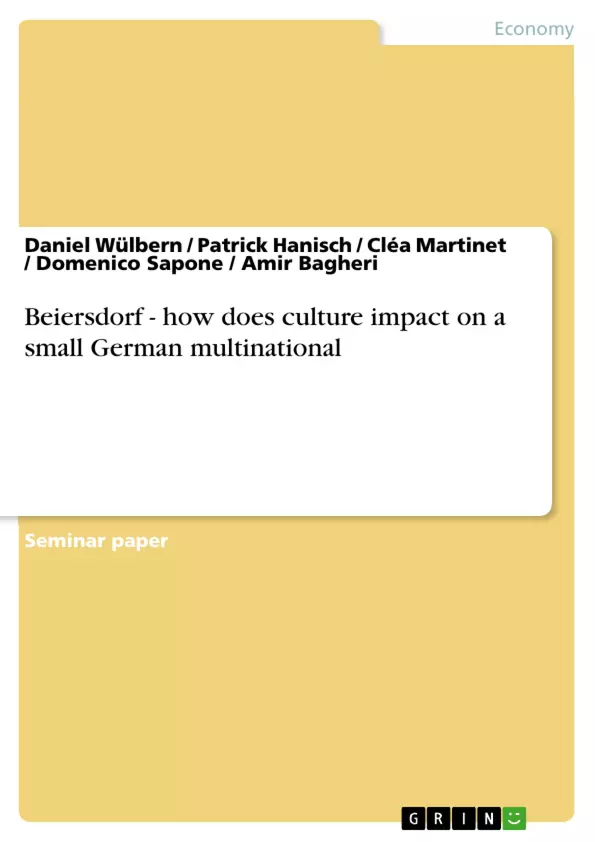This work deals with the way Beiersdorf’s does business in Europe. It considers the German impact of this particular culture on local practices, such as the organisational structure, human resource issues, team working or employee reward systems. First we introduce you to the firm behind Nivea, a product that is well known worldwide. Beiersdorf, though a relatively small company, is present around the world and therefore worth analysing. We than picked a cultural theory to base our analysis on. We chose the cultural framework as discussed by Hofstede, which is accepted throughout the scientific world as a useful tool. We will explain what is meant by the four considered dimensions and say how the UK, Germany and France fit into this framework. Then we outline BDFs values, beliefs and norms, as integral part of the Beiersdorf culture and how they partly reflect German values. In the end we will show how these values are set into practice in general and on a day-to-day basis.
Inhaltsverzeichnis (Table of Contents)
- Executive Summary
- Company description: Beiersdorf (BDF)
- Cultural Framework: Hofstede
- Measuring culture
- Four dimensions
- Cultural values, beliefs and norms
- The efficiency factor
- What about growth policy?
- Setting standards worldwide
- Strength from within: the Beiersdorfers
- Thinking globally, acting locally
- Learning company
- Analysis of Practices
- The organization in practice
- Beiersdorfers in practice
- A learning company in practice
- Quality in practice
- BDF-checklist for business success in different cultures
Zielsetzung und Themenschwerpunkte (Objectives and Key Themes)
This study examines the way Beiersdorf operates in Europe, particularly focusing on how the company's German culture influences its local practices. The objectives are to understand how Beiersdorf, a multinational company, navigates cultural differences and adapts its organizational structure, human resource management, team dynamics, and employee reward systems to various national contexts. Key themes explored include:- The impact of German cultural values on Beiersdorf's organizational practices
- The role of Hofstede's cultural framework in understanding cultural differences within Beiersdorf
- The specific cultural dimensions of power distance, uncertainty avoidance, individualism/collectivism, and masculinity/femininity
- The alignment of Beiersdorf's values and norms with its international operations
- The development of a "learning company" culture within Beiersdorf
Zusammenfassung der Kapitel (Chapter Summaries)
- The Executive Summary provides an overview of the study, highlighting Beiersdorf's global presence and its approach to managing cultural differences. It introduces the cultural framework used in the analysis, emphasizing Hofstede's dimensions and their application to the company.
- The chapter on Company Description: Beiersdorf (BDF) outlines the company's history, its product portfolio, and its growth trajectory. It details Beiersdorf's expansion into global markets and its commitment to offering high-quality products for everyday use.
- The chapter on Cultural Framework: Hofstede discusses the significance of measuring culture, highlighting the importance of understanding both cultural values and organizational practices. It then delves into Hofstede's four key cultural dimensions: Power Distance, Uncertainty Avoidance, Individualism/Collectivism, and Masculinity/Femininity, providing examples of how these dimensions manifest in different cultures.
Schlüsselwörter (Keywords)
This study focuses on the interplay between organizational behavior and cultural dynamics within a multinational company. Key concepts include: Beiersdorf, German culture, Hofstede's cultural framework, power distance, uncertainty avoidance, individualism/collectivism, masculinity/femininity, organizational practices, human resource management, team working, employee reward systems, learning company, and globalization.- Citar trabajo
- Daniel Wülbern (Autor), Patrick Hanisch (Autor), Cléa Martinet (Autor), Domenico Sapone (Autor), Amir Bagheri (Autor), 2002, Beiersdorf - how does culture impact on a small German multinational, Múnich, GRIN Verlag, https://www.grin.com/document/8850



